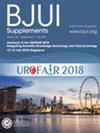Evaluating follow-up in patients with lymph node-negative penile cancer at a high-volume centre.
IF 3.7
2区 医学
Q1 UROLOGY & NEPHROLOGY
引用次数: 0
Abstract
OBJECTIVES To evaluate the current European Association of Urology/American Society of Clinical Oncology follow-up (FU) schedule with routine use of ultrasonography (US) ± US-guided fine-needle aspiration cytology (FNAC) in patients with lymph node (LN)-negative penile squamous cell carcinoma (PSCC). PATIENTS AND METHODS We evaluated FU outcomes for low-risk clinically LN-negative (cN0) and intermediate- to high-risk sentinel node (SN) negative (pathological N-stage [pN]0) patients with PSCC at a high-volume centre. We analysed routine inguinal US ± FNAC (in case of a suspicious LN) during FU. A competing risk analysis was performed to calculate the cumulative risk of LN metastases in these groups, with local recurrence as competing risk. RESULTS A total of 201 patients with PSCC were analysed, with 2694 inguinal US investigations being evaluated. FNAC was performed during 270 US procedures (10.0%). A LN metastasis was found in four of 270 US + FNAC procedures (1.5%, 0.2% of all US). All tumours were intermediate- to high-risk tumours. Three occurred within the first year after primary treatment, and one at 20 months. The cumulative risk of developing LN metastases in cN0 low-risk tumours was 0% (no events occurred) and in SN-negative intermediate- to high-risk group 2.0%, both at 1 year of FU. Two (out of four) patients with LN recurrence died from disease. CONCLUSION After adequate staging and treatment, patients with cN0/pN0 PSCC rarely develop LN metastasis during FU. As these metastases generally occur within 1 year after treatment, we recommend (3-monthly) routine inguinal US only during the first year of FU. Thereafter, the frequency of FU visits and examinations can be reduced in patients capable of self-examination of the penis, resulting in a substantial (up to a 50%) reduction of FU visits compared to current guideline recommendations.评价高容量中心淋巴结阴性阴茎癌患者的随访。
目的评价目前欧洲泌尿外科协会/美国临床肿瘤学会常规超声检查(US)±US引导细针穿刺细胞学检查(FNAC)对淋巴结(LN)阴性阴茎鳞状细胞癌(PSCC)患者随访(FU)计划。患者和方法我们在一个大容量中心评估了低风险临床n -阴性(cN0)和中高风险前哨淋巴结(SN)阴性(病理n期[pN]0)的PSCC患者的FU结果。我们分析了FU期间常规腹股沟US±FNAC(在可疑LN的情况下)。竞争风险分析计算了这些组中LN转移的累积风险,局部复发为竞争风险。结果共对201例PSCC患者进行了tsa分析,对2694例腹股沟US检查进行了评估。270例(10.0%)行FNAC。270例US + FNAC手术中有4例发现LN转移(占所有US的1.5%,0.2%)。所有肿瘤均为中高危肿瘤。3例发生在初次治疗后的一年内,1例发生在20个月后。在FU治疗1年时,cN0低危肿瘤发生LN转移的累积风险为0%(无事件发生),sn阴性中至高危组为2.0%。2 / 4的LN复发患者死于疾病。结论经过适当的分期和治疗,cN0/pN0 PSCC患者在FU期间很少发生淋巴结转移。由于这些转移通常发生在治疗后1年内,我们建议仅在FU的第一年(3个月)进行常规腹股沟超声检查。此后,对于能够自我检查阴茎的患者,FU就诊和检查的频率可以减少,与目前的指南建议相比,FU就诊次数大幅减少(高达50%)。
本文章由计算机程序翻译,如有差异,请以英文原文为准。
求助全文
约1分钟内获得全文
求助全文
来源期刊

BJU International
医学-泌尿学与肾脏学
CiteScore
9.10
自引率
4.40%
发文量
262
审稿时长
1 months
期刊介绍:
BJUI is one of the most highly respected medical journals in the world, with a truly international range of published papers and appeal. Every issue gives invaluable practical information in the form of original articles, reviews, comments, surgical education articles, and translational science articles in the field of urology. BJUI employs topical sections, and is in full colour, making it easier to browse or search for something specific.
 求助内容:
求助内容: 应助结果提醒方式:
应助结果提醒方式:


